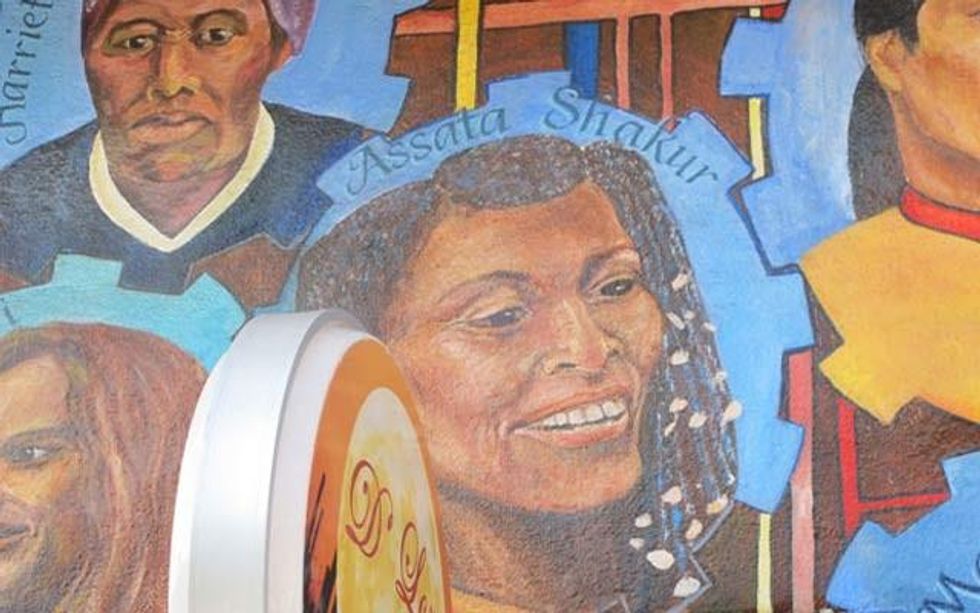Assata Shakur has been given many names over the past four decades. Her political allies in the 1970s struggle for black liberation knew her as a comrade and freedom fighter. Ever since her escape from a New Jersey prison and exile in Cuba, she's become an icon to many on the radical left. Some, mostly critics, still call her by her birth name, Joanna Chesimard. Now the Federal Bureau of Investigation has a new name for her: terrorist.
On May 2 the FBI and the New Jersey State Police announced that Shakur had become the first woman to be added to the agency's list of Most Wanted Terrorists. Why? Because in 1977, Shakur was convicted of a slew of criminal charges, including the first degree murder of police officer Werner Forester, after a shootout on the New Jersey Turnpike. (Previously, she had been unsuccessfully prosecuted in six other criminal cases, including bank robbery.) After her conviction for the murder of Forester, Shakur was sentenced to life in prison. But on Nov. 2, 1979, she escaped, then turned up five years later in Cuba, where she has held political exile.
Shakur maintains her innocence, and notes that the State Police's own investigation found that there was no gunpowder residue on her hands at the time of her arrest. She's remained an outspoken critic of racism in the United States and become an iconic symbol for many in the racial justice community. Her book, "Assata: An Autobiography" is just one part of the immense cultural impact she's had.
However, in all the years since her escape, the FBI has not given up its search for Shakur. "No person, no matter what his or her political or moral convictions are, is above the law. Joanne Chesimard is a domestic terrorist who murdered a law enforcement officer execution-style," FBI special agent Aaron Ford said recently at a press conference.
So she's on the terror list. But for many, that new designation has begged the question: What exactly does it mean to be on one of the FBI's wanted lists?
History of the Lists
To understand how the FBI's Most Wanted lists work, it's important to know how they were developed. At their core, the lists are tools for publicity. They don't confer any new legal status, according to the FBI's website.
The idea for a most wanted list was born in 1949 during a conversation between FBI Director J. Edgar Hoover and a reporter, William Kinsey Hutchinson, who discussed ways to capture the agency's "toughest guys." As recounted in an interactive timeline at the Washington Post, that discussion eventually gave way to a published article and, on March 14, 1950, the FBI officially announced that it would use the list to help in its search for the country's most dangerous criminals.
Shakur is the latest in a long list of black revolutionaries who have been among the FBI's most sought after criminal suspects. Angela Davis famously made the list in 1970; H. Rap Brown got on it a year later in 1971; the Black Liberation Army's Twymon Myers made the list in 1973, before being shot and killed by police; and the BLA's Mutulu Shakur was added in 1982, until he was captured in 1986. Thanks to COINTELPRO, the FBI's intensive countersurveillance program, leading black activists of the era were all but ensured to be targeted. "The Black Panther Party, without question, represents the greatest threat to internal security of the country," FBI Director J. Edgar Hoover said in 1969, underscoring his contempt for radical black activists.
But Assata Shakur finds herself not in the company of these activists, but rather alongside Taliban and Hezbollah leaders on the agency's most wanted terrorist list, which was formed in the immediate aftermath of 9/11.
Take a look at the FBI's profile of Shakur on its website, and this is what you will find: a list of 23 aliases, the FBI's account of her conviction and escape, two birthdates, and a warning that Shakur "may wear her hair in a variety of styles and dress in African tribal clothing." Noticeably, she is one of only two American-born people listed, the only woman, and the only person of African descent. Conspicuously missing from the list is any mention of the more than 1,000 white hate groups operating across the United States.
The 'Chosen' Ones
Each person who is listed as an alleged terrorist by the FBI has been indicted by a federal grand jury. For the Most Wanted Fugitives list, meanwhile, each one of the FBI's 56 national field offices submits candidates. The lists are distributed in public places like post offices.
The average award for someone on one of the Most Wanted lists is $100,000; the FBI is offering $1 million for Shakur (the New Jersey State Police have matched the FBI's money, bringing the total amount to $2 million). The Rewards for Justice Program, which is administered by the State Department's Bureau of Diplomatic Security, puts up the money to catch suspected terrorists, who remain on the list until they're caught, killed, or exonerated.
In an open letter dating back at least to 1998, Shakur made her case to the public:
Like most poor and oppressed people in the United States, I do not have a voice. Black people, poor people in the U.S. have no real freedom of speech, no real freedom of expression and very little freedom of the press. The black press and the progressive media has historically played an essential role in the struggle for social justice. We need to continue and to expand that tradition. We need to create media outlets that help to educate our people and our children, and not annihilate their minds. I am only one woman. I own no TV stations, or Radio Stations or Newspapers. But I feel that people need to be educated as to what is going on, and to understand the connection between the news media and the instruments of repression in Amerika. All I have is my voice, my spirit and the will to tell the truth.
For many of her supporters, Shakur's addition to the list is a symbolic threat to today's young activists. Angela Davis told "Democracy Now!" last week that "it seems to me that the attack on her reflects the logic of terrorism, because it precisely is designed to freighten young people, especially today, who would be involved in the kind of radical activism that might lead to change."



